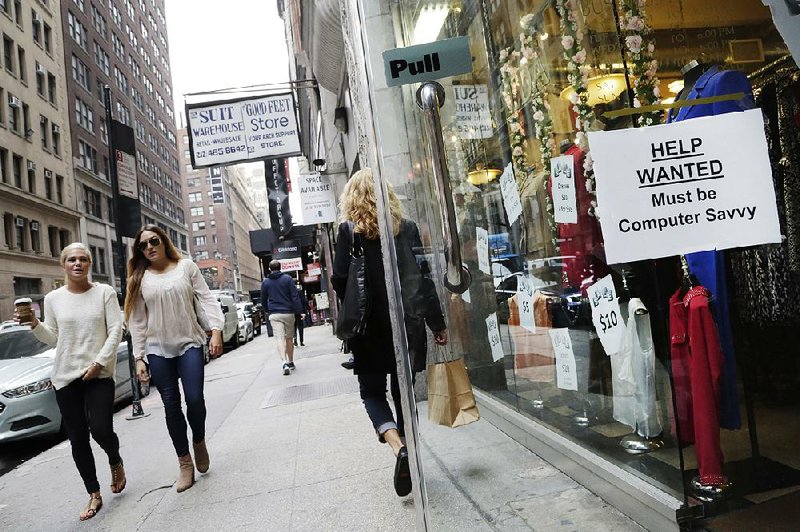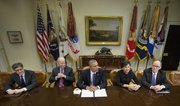WASHINGTON -- U.S. employers added a robust 242,000 workers in February as retailers, restaurants and health care providers drove another solid month for the resilient American job market. The unemployment rate remained at 4.9 percent.
Average hourly earnings dropped, the first monthly decline in more than a year.
The job gains show that the U.S. economy has weathered a global economic slowdown and falling financial markets. The improvement will help ease fears that arose in recent weeks that a new U.S. recession might be looming.
"Overall employment growth remains strong despite the global head winds," said Jim O'Sullivan, chief U.S. economist at High Frequency Economics in Valhalla, N.Y. "There's not a lot of slack left in the job market."
Friday's jobs report from the government also is sure to be closely monitored by the Federal Reserve and presidential candidates as a gauge of how well the economy is extending its 6½-year rebound since the last recession.
In addition to the healthy job gain for February, the government also revised up its estimates of job growth in December and January by a combined 30,000. Over the past three months, employers have added on average a strong 228,000 jobs.
"Neither global head winds, financial turbulence nor political uncertainty has dimmed American businesses' enthusiasm for hiring," said Sal Guatieri, a senior economist at BMO Capital Markets. "The solid jobs report should allay recession fears."
Four years ago, at this point in the last presidential election cycle, the unemployment rate was at 8.3 percent and the economic recovery was in a relatively early stage. Then, worries centered on rising gasoline prices, deep consumer debt and government layoffs.
Now, the recovery is in its seventh year, the unemployment rate has dropped sharply and the private sector has chalked up 72 months of uninterrupted job gains, the longest streak on record. Oil prices may still be causing ulcers, but this time it is producers who are feeling the pain, because the prices have plunged.
Employers expect solid consumer demand in the months ahead even though the stock market has turned turbulent, oil prices have hurt energy industry jobs and a stronger dollar has reduced export sales.
Some economists also suggested that the jobs report created a path for the Fed to raise interest rates again as early as June, according to many economists. The Fed raised rates from record lows in December.
Low unemployment has historically caused the Fed to raise its benchmark rate for short-term lending. But Fed officials have held off after the December increase because of concerns about low inflation and the weak global economy.
"It's probably a better-than 50 percent proposition that they will raise the rates in June," said Kevin Logan, chief U.S. economist at the bank HSBC.
Retailers added 54,900 jobs last month. Restaurants and bars added 40,200, the health care sector 38,100, and construction companies 19,000.
Hiring by employers that are directly associated with consumers has more than offset layoffs at manufacturers and fossil fuel companies -- two sectors squeezed by the pressures of uncertainty in China, sluggishness in Europe, declining oil prices and a stronger dollar.
Job losses for the mining sector -- an area that includes the battered energy industry -- have totaled 140,400 in the past 12 months. And manufacturing has added just 12,000 jobs over that time.
Consumers have provided the foundation for much of the job market's improvement in what's become something of a self-sustaining cycle. The nearly 2.7 million workers who have been added over the past 12 months have bolstered spending on autos, housing and restaurant meals.
With unemployment remaining low, economists say more companies should begin to raise pay to attract workers, thereby fueling more hiring and increasing people's ability to spend, invest and save.
For years, one of the key weaknesses of the economic recovery has been tepid pay growth. Many of the jobs created after the recession were in lower-paid occupations -- from cashiers, waiters and store clerks to home health aides and temporary workers.
But in recent months, wage gains began to tick upward. The increases bolstered hopes that employers were raising pay to keep workers. Over the past 12 months, average hourly earnings have risen 2.2 percent, compared with an annual increase of 1.9 percent a year ago.
Yet between January and February, earnings fell slightly in a setback for workers hoping for further gains. The Labor Department reported a 0.1 percent drop in average hourly wages in February. The decline followed a 0.5 percent gain in January that had raised hopes of a long-awaited pickup in pay.
Ian Shepherdson, chief economist at Pantheon Macroeconomics, said wages might have slipped last month because the survey for the jobs report occurred before Feb. 15, which is often a payday for people who are paid semimonthly.
Wage growth is often tepid when the jobs report survey week doesn't include the 15th of the month, Shepherdson noted.
Still, steady hiring in recent months has translated into more consumer spending in several key sectors. Auto sales rose 7 percent over last February to 1.3 million vehicles, according to Autodata Corp.
Purchases of previously owned homes rose 0.4 percent last month to a seasonally adjusted annual rate of 5.47 million, according to the National Association of Realtors. That improvement followed a solid 2015, when sales achieved their highest level in nine years.
And spending at restaurants has risen 6.1 percent over the past 12 months.
Troubles abroad have tempered U.S. economic growth. China, the world's second-largest economy, is struggling with high corporate debts and slower growth. Oil prices have tumbled as demand remains relatively low. The strong dollar has crushed exports, while the stock market has dropped in an extended bout of volatility this year.
Information for this article was contributed by Josh Boak of The Associated Press; by Shobhana Chandra and Carlos Torres of Bloomberg News; and by Patricia Cohen of The New York Times.
Business on 03/05/2016

